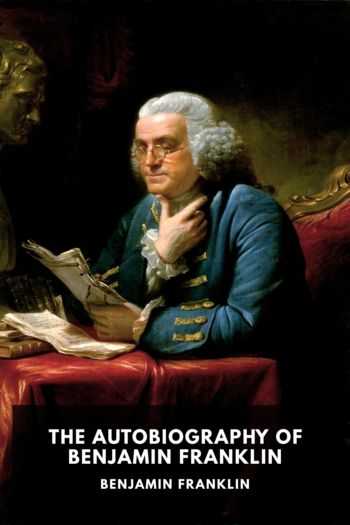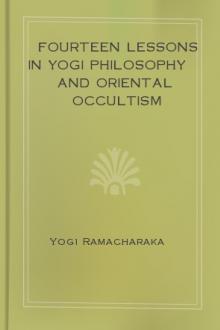Autobiography of a Yogi by Paramahansa Yogananda (self help books to read txt) 📕

- Author: Paramahansa Yogananda
- Performer: 978-0876120835
Book online «Autobiography of a Yogi by Paramahansa Yogananda (self help books to read txt) 📕». Author Paramahansa Yogananda
Untying the cord of breath which binds the soul to the body, KRIYA serves to prolong life and enlarge the consciousness to infinity. The yoga method overcomes the tug of war between the mind and the matter-bound senses, and frees the devotee to reinherit his eternal kingdom. He knows his real nature is bound neither by physical encasement nor by breath, symbol of the mortal enslavement to air, to nature’s elemental compulsions.
Introspection, or “sitting in the silence,” is an unscientific way of trying to force apart the mind and senses, tied together by the life force. The contemplative mind, attempting its return to divinity, is constantly dragged back toward the senses by the life currents. KRIYA, controlling the mind DIRECTLY through the life force, is the easiest, most effective, and most scientific avenue of approach to the Infinite. In contrast to the slow, uncertain “bullock cart” theological path to God, KRIYA may justly be called the “airplane” route.
The yogic science is based on an empirical consideration of all forms of concentration and meditation exercises. Yoga enables the devotee to switch off or on, at will, life current from the five sense telephones of sight, sound, smell, taste, and touch. Attaining this power of sense-disconnection, the yogi finds it simple to unite his mind at will with divine realms or with the world of matter. No longer is he unwillingly brought back by the life force to the mundane sphere of rowdy sensations and restless thoughts. Master of his body and mind, the KRIYA YOGI ultimately achieves victory over the “last enemy,” death.
So shalt thou feed on Death, that feeds on men: And Death once dead, there’s no more dying then. {FN26-13}
The life of an advanced KRIYA YOGI is influenced, not by effects of past actions, but solely by directions from the soul. The devotee thus avoids the slow, evolutionary monitors of egoistic actions, good and bad, of common life, cumbrous and snail-like to the eagle hearts.
The superior method of soul living frees the yogi who, shorn of his ego-prison, tastes the deep air of omnipresence. The thralldom of natural living is, in contrast, set in a pace humiliating. Conforming his life to the evolutionary order, a man can command no concessionary haste from nature but, living without error against the laws of his physical and mental endowment, still requires about a million years of incarnating masquerades to know final emancipation.
The telescopic methods of yogis, disengaging themselves from physical and mental identifications in favor of soul-individuality, thus commend themselves to those who eye with revolt a thousand thousand years. This numerical periphery is enlarged for the ordinary man, who lives in harmony not even with nature, let alone his soul, but pursues instead unnatural complexities, thus offending in his body and thoughts the sweet sanities of nature. For him, two times a million years can scarce suffice for liberation.
Gross man seldom or never realizes that his body is a kingdom, governed by Emperor Soul on the throne of the cranium, with subsidiary regents in the six spinal centers or spheres of consciousness. This theocracy extends over a throng of obedient subjects: twenty-seven thousand billion cells-endowed with a sure if automatic intelligence by which they perform all duties of bodily growths, transformations, and dissolutions-and fifty million substratal thoughts, emotions, and variations of alternating phases in man’s consciousness in an average life of sixty years. Any apparent insurrection of bodily or cerebral cells toward Emperor Soul, manifesting as disease or depression, is due to no disloyalty among the humble citizens, but to past or present misuse by man of his individuality or free will, given to him simultaneous with a soul, and revocable never.
Identifying himself with a shallow ego, man takes for granted that it is he who thinks, wills, feels, digests meals, and keeps himself alive, never admitting through reflection (only a little would suffice!) that in his ordinary life he is naught but a puppet of past actions (karma) and of nature or environment. Each man’s intellectual reactions, feelings, moods, and habits are circumscribed by effects of past causes, whether of this or a prior life. Lofty above such influences, however, is his regal soul. Spurning the transitory truths and freedoms, the KRIYA YOGI passes beyond all disillusionment into his unfettered Being. All scriptures declare man to be not a corruptible body, but a living soul; by KRIYA he is given a method to prove the scriptural truth.
“Outward ritual cannot destroy ignorance, because they are not mutually contradictory,” wrote Shankara in his famous CENTURY OF VERSES. “Realized knowledge alone destroys ignorance… . Knowledge cannot spring up by any other means than inquiry. ‘Who am I? How was this universe born? Who is its maker? What is its material cause?’ This is the kind of inquiry referred to.” The intellect has no answer for these questions; hence the rishis evolved yoga as the technique of spiritual inquiry.
KRIYA YOGA is the real “fire rite” often extolled in the BHAGAVAD GITA. The purifying fires of yoga bring eternal illumination, and thus differ much from outward and little-effective religious fire ceremonies, where perception of truth is oft burnt, to solemn chanted accompaniment, along with the incense!
The advanced yogi, withholding all his mind, will, and feeling from false identification with bodily desires, uniting his mind with superconscious forces in the spinal shrines, thus lives in this world as God hath planned, not impelled by impulses from the past nor by new witlessnesses of fresh human motivations. Such a yogi receives fulfillment of his Supreme Desire, safe in the final haven of inexhaustibly blissful Spirit.
The yogi offers his labyrinthine human longings to a monotheistic bonfire dedicated to the unparalleled God. This is indeed the true yogic fire ceremony, in which all past and present desires are fuel consumed by love divine. The Ultimate Flame receives the sacrifice of all human madness, and man is pure of dross. His bones stripped of all desirous flesh, his karmic skeleton bleached in the antiseptic suns of wisdom, he is clean at last, inoffensive before man and Maker.
Referring to yoga’s sure and methodical efficacy, Lord Krishna praises the technological yogi in the following words: “The yogi is greater than body-disciplining ascetics, greater even than the followers of the path of wisdom (JNANA YOGA), or of the path of action (KARMA YOGA); be thou, O disciple Arjuna, a yogi!” {FN26-14}
{FN26-1} The noted scientist, Dr. George W. Crile of Cleveland, explained before a 1940 meeting of the American Association for the Advancement of Science the experiments by which he had proved that all bodily tissues are electrically negative, except the brain and nervous system tissues which remain electrically positive because they take up revivifying oxygen at a more rapid rate.
{FN26-2} BHAGAVAD GITA, IV:29.
{FN26-3} BHAGAVAD GITA IV:1-2.
{FN26-4} The author of MANAVA DHARMA SHASTRAS. These institutes of canonized common law are effective in India to this day. The French scholar, Louis Jacolliot, writes that the date of Manu “is lost in the night of the ante-historical period of India; and no scholar has dared to refuse him the title of the most ancient lawgiver in the world.” In LA BIBLE DANS L’INDE, pages 33-37, Jacolliot reproduces parallel textual references to prove that the Roman CODE OF JUSTINIAN follows closely the LAWS OF MANU.
{FN26-5} The start of the materialistic ages, according to Hindu scriptural reckonings, was 3102 B.C. This was the beginning of the Descending Dwapara Age (see page 174). Modern scholars, blithely believing that 10,000 years ago all men were sunk in a barbarous Stone Age, summarily dismiss as “myths” all records and traditions of very ancient civilizations in India, China, Egypt, and other lands.
{FN26-6} Patanjali’s APHORISMS, II:1. In using the words KRIYA YOGA, Patanjali was referring to either the exact technique taught by Babaji, or one very similar to it. That it was a definite technique of life control is proved by Patanjali’s APHORISM II:49.
{FN26-7} Patanjali’s APHORISMS, I:27.
{FN26-8} “In the beginning was the Word, and the Word was with God, and the Word was God… . All things were made by him; and without him was not any thing made that was made.”-JOHN 1:1-3. AUM (OM) of the VEDAS became the sacred word AMIN of the Moslems, HUM of the Tibetans, and AMEN of the Christians (its meaning in Hebrew being SURE, FAITHFUL). “These things saith the Amen, the faithful and true witness, the beginning of the creation of God.”-REVELATIONS
3:14.
{FN26-9} APHORISMS II:49..
{FN26-10} I CORINTHIANS 15:31. “Our rejoicing” is the correct translation; not, as usually given, “your rejoicing.” St. Paul was referring to the OMNIPRESENCE of the Christ consciousness..
{FN26-11} KALPA means time or aeon. SABIKALPA means subject to time or change; some link with PRAKRITI or matter remains. NIRBIKALPA means timeless, changeless; this is the highest state of SAMADHI.
{FN26-12} According to the LINCOLN LIBRARY OF ESSENTIAL INFORMATION, p. 1030, the giant tortoise lives between 200 and 300 years.
{FN26-13} Shakespeare: SONNET #146.
{FN26-14} BHAGAVAD GITA, VI:46.
CHAPTER: 27
FOUNDING A YOGA SCHOOL AT RANCHI
“Why are you averse to organizational work?”
Master’s question startled me a bit. It is true that my private conviction at the time was that organizations were “hornets’ nests.”
“It is a thankless task, sir,” I answered. “No matter what the leader does or does not, he is criticized.”
“Do you want the whole divine CHANNA (milk curd) for yourself alone?” My guru’s retort was accompanied by a stern glance. “Could you or anyone else achieve God-contact through yoga if a line of generous-hearted masters had not been willing to convey their knowledge to others?” He added, “God is the Honey, organizations are the hives; both are necessary. Any FORM is useless, of course, without the spirit, but why should you not start busy hives full of the spiritual nectar?”
His counsel moved me deeply. Although I made no outward reply, an adamant resolution arose in my breast: I would share with my fellows, so far as lay in my power, the unshackling truths I had learned at my guru’s feet. “Lord,” I prayed, “may Thy Love shine forever on the sanctuary of my devotion, and may I be able to awaken that Love in other hearts.”
On a previous occasion, before I had joined the monastic order, Sri Yukteswar had made a most unexpected remark.
“How you will miss the companionship of a wife in your old age!” he had said. “Do you not agree that the family man, engaged in useful work to maintain his wife and children, thus plays a rewarding role in God’s eyes?”
“Sir,” I had protested in alarm, “you know that my desire in this life is to espouse only the Cosmic Beloved.”
Master had laughed so merrily that I understood his observation was made merely as a test of my faith.
“Remember,” he had said slowly, “that he who discards his worldly duties can justify himself only by assuming some kind of responsibility toward a much larger family.”
The ideal of an all-sided education for youth had always been close to my heart. I saw clearly the arid results of ordinary instruction, aimed only at the development of body and intellect. Moral and spiritual values, without whose appreciation no man can approach happiness, were yet lacking in the formal curriculum. I determined to found a school where young boys could develop to the full stature of manhood. My first step in that direction was made with seven children at Dihika, a small country site in Bengal.
A year later, in 1918, through the generosity of Sir Manindra Chandra





Comments (0)